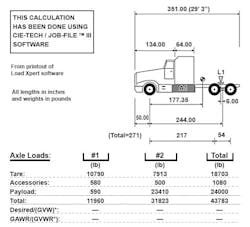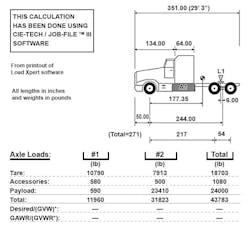Determining Gross Vehicle Weight Rating (GVWR) for Trailers: Here’s how
This article authored jointly by Don Moore and Eddy Tschirhart, Canadian Transportation Equipment Association
In our last IdeaXchange, we looked at a list of factors that affect the gross vehicle weight rating of a trailer. Now let’s plug those factors into two formulas to calculate what the GVWR of the trailer objectively should be.
The Truck Trailer Manufacturers Association (TTMA) publishes a document which provides two methods that can be used to determine GVWR of trailers. This document is TTMA RP # 39. It is available through the CTEA.
The first equation in this document is very simple:
Tare Weight + Rated Payload = GVWR.
The second equation is:
Upper Coupler Vertical Load or Front Tow bar Coupler Vertical Load + GAWR (s) = GVWR.;
The GVWR should be based on the following: kingpin, drawbar or suspension settings with a water-level load, the kingpin set of 36” from the nose of trailer with the rearmost axle set 36” from the rear. If the trailer has a moveable suspension, it should be located in the foremost position. Lift, removable, or flip axles must be attached and deployed.
No matter which method is used to derive the GVWR of a trailer, it must be understood that the GVWR may not exceed the structural capability of the trailer.
Unfortunately, many companies say that intended use and payload are often not known to the designer of the trailer. But ironically these issues have to be factored in as they play a major role in the wellbeing of the trailer and the determination of the GVWR. Care must be taken to use reasonable analysis to determine the rating and what capabilities could be expected of vehicles your company is or intends to manufacture.
Trailer GVWR along with each GAWR should not be taken lightly, as it is the yardstick that may be used for heavy load over-weight permits. Some jurisdictions use these ratings for the issuance of over load permits. In the event of forensic investigation in follow up to an accident or a product failure, these ratings will again come into play.
From my standpoint, in putting this article together, I have always liked using figures to illustrate the process. When you are designating a trailer GVWR, it is wise to use the figures that are needed for calculating weight distribution.
I suggest that you take a look at what is required for kingpin weight to ensure that the weight distribution works out for various jurisdictions’ weight laws. If building trailers for Canada, a trailer builder would be advised to look at the requirements in each province and territory.
Let’s look at the common tandem tractor, tandem semi-trailer configuration that could run throughout North America using a flat deck, step deck or dry freight van trailer. This configuration would have an 80,000-pound/36,287 kilogram gross. Let’s consider a tractor with a tare weight (including 150 US gallons fuel) of 19,783 pounds/8,973 kilograms and a wheelbase of 244 inches/6.2 meters.
As can be seen with the following calculation, to properly transfer load to the tractor, there is a kingpin weight of 24,000 pounds/10,886 kilograms needed to reach allowable axle loadings. In this case the allowable axle loading on the tractor front axle is 12,000 pounds/5,443 kilograms and 32,000 pounds/14,514 kilograms on the drives.
As can be seen in this example, a hitch rating for the trailer at less than 24,000 pounds/10,886 kilograms would be short-changing the customer. When looking at the process of developing a trailer GVWR in the lowest case condition, it would advisable to go for nothing less than 28,000 pounds/12,700 kilograms. This is the reason that many tractors will have a tare weight of up to 2,500 pounds/1, 133 kilograms less than what I have used in this example.
Trailer GVWR is derived using the running gear and the hitch ratings
The trailer, from a structural point of view, must be built with a strong enough beam to handle the payload and beam weight. There is no written standard in the regulations regarding this point, but it really has to be understood from a structural design and safety point of view.
The sample used is a lighter trailer. However, the same procedure holds for a heavier unit.
I have one more important note regarding the GVWR for trailers that must be pointed out. In heavy-haul application, the equipment that could be subjected to running on heavy permits etc. will only be permitted in some jurisdictions to a maximum rating that has been certified by the vehicle manufacturer for the unit. The example that I have heard cited for axles is up to that which the trailer manufacturer has stated on the vehicle compliance label.
In closing, a general note for the record keeping in trailer manufacturing. Care must be taken to keep all engineering analysis, construction changes, etc., up to date at all times. The calculations used must be maintained for future design use and products liability risk management.
About the Author
Don Moore
Executive Director
Don has been in the Heavy commercial vehicle manufacturing industry for over 30 years. Over half of his career was spent as an engineer at Western Star Trucks in Kelowna, BC.
During the past 9 years Don has been the Executive Director of the Canadian Transportation Equipment Association working closely with trailer and vocational truck manufacturer members, federal and provincial government officials, and suppliers to the industry dealing with regulatory issues pertaining to heavy vehicle manufacturing. Although advocacy is only part of his responsibility, it is arguably the highest priority of his many duties.



